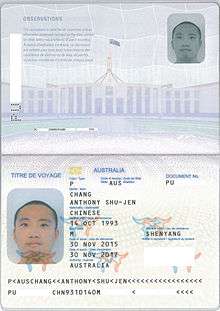Refugee travel document


A refugee travel document (also called a 1951 Convention travel document or Geneva passport) is a travel document issued to a refugee by the state in which she or he normally resides allowing him or her to travel outside that state and to return there. Refugees are unlikely to be able to obtain passports from their state of nationality (from which they have sought asylum) and therefore need travel documents so that they might engage in international travel.
The 145 states which are parties to the 1951 Convention Relating to the Status of Refugees are obliged to issue travel documents to refugees lawfully resident in their territory.[1]
Refugee travel documents are passport-like booklets. Their cover bears the words "Travel Document" in English and French (and often in the language of the issuing state), as well as the date of the convention: 28 July 1951. The documents were originally grey, though some countries now issue them in other colours, with two diagonal lines in the upper left corner of the front cover. Bearers enjoy certain visa-free travel privileges extended by signatories to the convention.
Travel documents issued to refugees

- New Zealand Refugee Travel Document
- Estonian travel document for refugees
- Refugee Travel Document (United States)[2]
- Australian Convention Travel Document. This document by itself does not allow the bearer to return to Australia; for that, a separate visa must be obtained.[3]
- Swiss Travel Document

Limitations of a refugee travel document compared to a passport
Refugee travel documents issued by the Government of Canada cannot be used for travel to the bearer’s country of citizenship,[4] and a refugee travel document issued by another country is not treated as a valid passport for the purposes of obtaining an Electronic Travel Authorization to visit Canada.[5]
See also
- Refugee identity certificate
- Travel document
- 1954 Convention Travel Document, for stateless persons
- Certificate of identity, for stateless persons or others
- Nansen passport, the predecessor of the Refugee travel document
National non-citizen travel documents
- Canadian Certificate of Identity
- Japan Re-entry Permit
- Australian Certificate of Identity. This document by itself does not allow the bearer to return to Australia; for that, a separate visa must be obtained.[6]
Footnotes
- ↑ Under Article 28 of the Convention.
- ↑ Travel Documents, USCIS
- ↑ Convention Travel Documents (CTD)
- ↑ "Types of passports and travel documents". Government of Canada. 2015-06-26. Retrieved 2015-12-09.
- ↑ "Apply for an Electronic Travel Authorization (eTA)". Government of Canada. 2015-11-18. Retrieved 2015-12-09.
- ↑ Certificate of Identity(COI)
External links
| Wikimedia Commons has media related to Convention (1951) travel documents. |
- Travel documents Passport Canada
- 1951 Convention travel document Images from Passportland.com